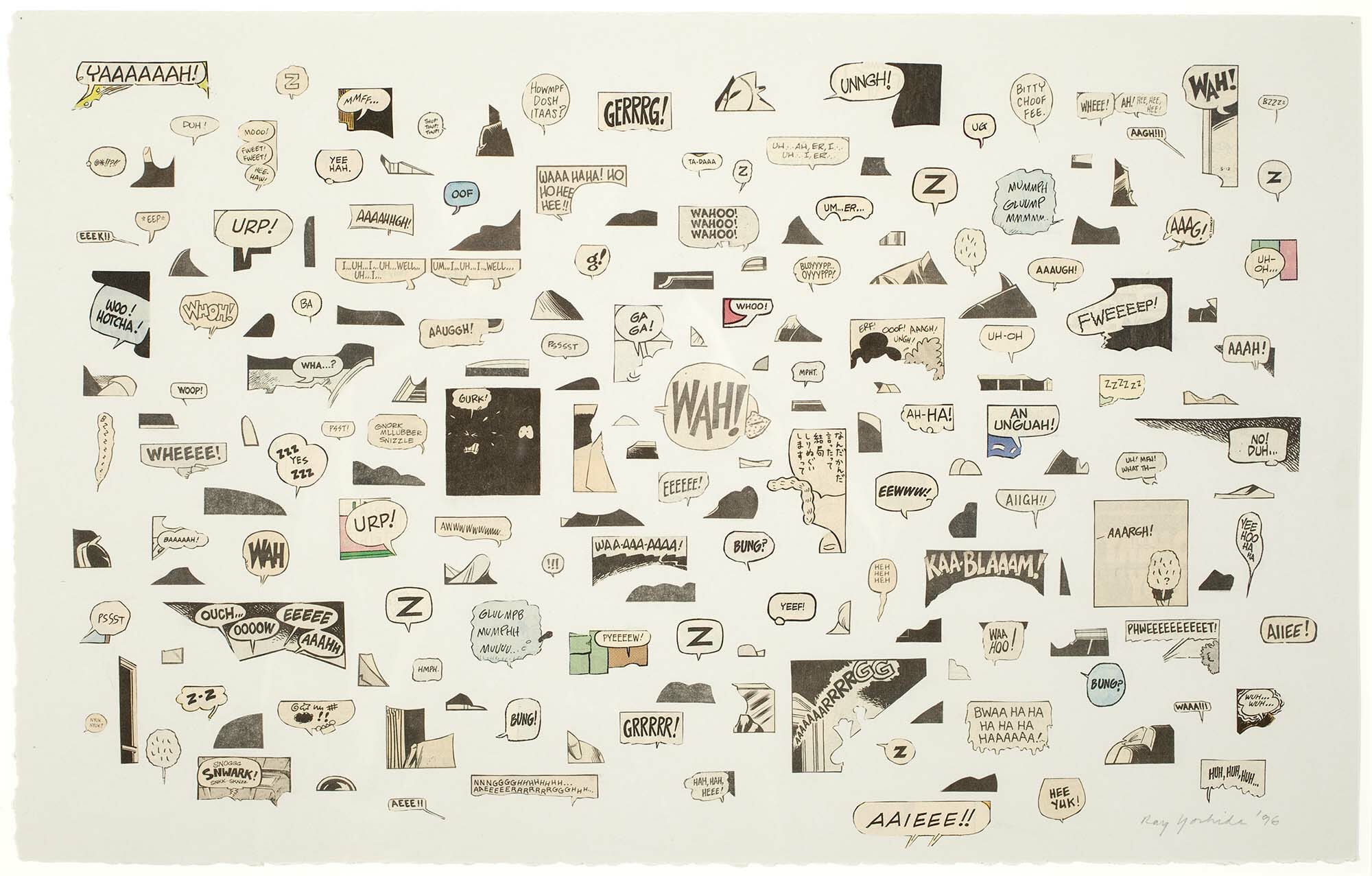
Lesson Plan | Ray Yoshida: Mixed Media Collages – MMoCA
Artwork
AAIEEE!, 1996, collage on paper
Subjects
Visual Art, Language Arts
Author
Andrea Maxworthy O’Brien, Professor Emerita, University of Wisconsin–Whitewater
Essential Questions
How do ordinary objects become art? How are words used in art? How does knowing the contexts histories, and traditions of art forms help us create works of art and design? Why do artists follow or break from established traditions? How do artists determine what resources and criteria re needed to formulate artistic investigations?
Grade Level
6th–9th grades
Objectives
Students will consider examples of onomatopoeia and the use of onomatopoeia in comic strips. Students will create a mixed media collage with one example of onomatopoeia.
Activity
Introduce AAIEEE! by Ray Yoshida, and onomatopoeia. Ray Yoshida was a collector, a pack rat, who collected objects from junk shops, second hand stores, and flea markets. These ordinary objects influenced his art. (YouTube video of Ray Yoshida’s Museum of Extraordinary Values https://www.youtube.com/watch?v=c6CdEG0Tr9A)
Define onomatopoeia (a word that imitates the sound it describes like “buzz” or “tick-tock”) by sharing examples.
Show students examples of comic strips containing onomatopoeia (note: search online using the key words “onomatopoeia comics.” Good examples are Garfield, Batman). Teacher and students brainstorm additional list of onomatopoeia words (see http://examples.yourdictionary.com/5-examples-of-onomatopoeia.html).
Optional: Students create a scrapbook of comic strip examples of onomatopoeia to inspire their multimedia collage construction
Enduring Understanding
Artists and designers shape artistic investigations, following or breaking with traditions in pursuit of creative artmaking goals.
Discussion Questions
- What similarities does AAIEEE! share with a comic book or comic strips? How is Ray Yoshida’s art different from a comic?
- What qualities of the comics attract people’s interest?
- How do the words in this image contribute to the meaning of Yoshida’s work?
- If you look closely, what words or phrases do you recognize? (examples: urp, whee, yaah, KAA-Blam, Grr!, Gurk?)
- What difference might the particular style or appearance of words make to the meaning of an artwork?
- How do the words and images work together to create meaning in the work of art?
Instructions
Construction of a Mixed Media Collage
Students choose an example of onomatopoeia for the center of the collage; for example, “splat.”
Students create the word by drawing with markers, using construction paper to create letters, or using letter stencils. Students should consider the sound of the word when choosing their materials, colors, and letter shape. Teacher may provide stencils.
Students glue a base of newspaper or magazine clippings onto a sheet of construction paper.
Students create a frame suitable for the sound of the word using construction paper or paint. The teacher may provide templates that can be glued or painted onto the newspaper base.
Optional: Students can add objects that make a sound by drawing or painting them, or by attaching a found object to their collage.
Resources
An Artist’s Strangely Compelling 1960’s Scrapbook of Comic Book Art
http://www.slate.com/blogs/the_vault/2015/08/21/art_of_ray_yoshida_comic_book_scrapbooks_from_the_archives_of_american_art.html
Archives of American Art, Smithsonian Institution: Newspaper Comic Clippings, Ray Yoshida’s Scrapbook of Comic Book Clippings, Ray Yoshida Scrapbook of Advertisement Clippings
https://www.si.edu/spotlight/source-material/ray-yoshida
You Tube video Ray Yoshida’s Museum of Extraordinary Values
https://www.youtube.com/watch?v=c6CdEG0Tr9A
Examples of onomatopoeia
http://examples.yourdictionary.com/5-examples-of-onomatopoeia.html
Buzz! Thwack! How sounds become words activity
http://www.sciencemag.org/news/2016/03/buzz-thwack-how-sounds-become-words
Materials
Old newspapers, magazines, paint, scissors, construction paper, glue sticks, examples of comic strips with onomatopoeia
Vocabulary
collage, onomatopoeia, found objects, mixed media
Extensions
Language Arts
Standards
Wisconsin State Standards
Art and Design: A.8.6 / B.8.5 / C.8.7 / G.8.4 / J.8.10; Language Arts: A.8.3 / C.8.3 / D.8.1

